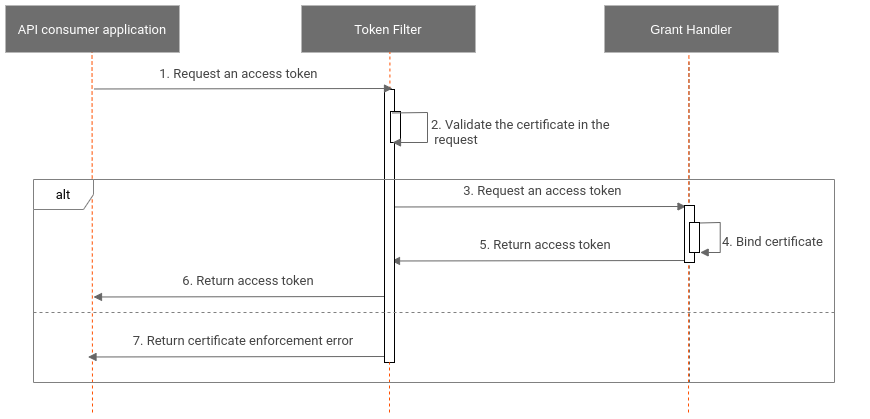Token Authentication
When an API consumer registers an application, a consumer-key and a consumer-secret is given for that application. These are the credentials of the application that is being registered. The consumer-key becomes the unique identifier of the application, which is similar to a username that is used for authentication. When an access token is issued for the application, it is issued against the latter mentioned consumer-key.
API consumers generate access tokens and pass them in the incoming API requests. The generated access token is a simple
string that you need to pass as an HTTP header. For example, "Authorization: Bearer NtBQkXoKElu0H1a1fQ0DWfo6IX4a".
WSO2 Open Banking Accelerator supports two types of access tokens for authentication:
-
Application Access Tokens: Tokens to identify and authenticate an application.
-
User Access Tokens: Tokens to identify the final user of an application.
For more information on access tokens, see the overview of access tokens in WSO2 API Manager documentation.
In order to cater to any open banking requirement, WSO2 Open Banking Accelerator contains the following access token features:
Certificate-bound access tokens¶
Certificate-bound access tokens are access tokens that have a certificate attached to them. When using certificate-bound access tokens, you need to pass the certificate, which is bound to the token to gain access to protected resources. This prevents attacks to the access tokens from unauthorized parties. The validation for such tokens take place as follows:
-
Step 1: During the token API invocation, ensure that the transport certificate is passed as a header or in the context. This is performed by a Token Filter before the API hits the authorization server.
-
Step 2: Bind the transport certificate to the access token via the confirmation (
cnf) claim. All Grant Handler types (authorization_code,client_credentials, andrefresh_token) bind the transport certificate hash to the token using thecnfclaim. -
Step 3: Return the
cnfclaim via an access token, thecnfclaim ensures that the certificate is bound to the access token. -
Step 4: Validate the certificate during the API invocation. The API Manager server needs to ensure that the certificate being passed during the API call is the same certificate that is bound to the token.
The diagram below explains the flow and how the Grant Handler and Token Filters engage:

Token Filter¶
A Token Filter is engaged at the Servlet container level before the request approaches the Token API. The Token Filter engages the following validators:
-
MTLS enforcement validator: This enforces that a certificate needs to be passed during the token creation. This certificate is then bound to the access token.
To decode the certificate when it is passed from the load balancer to the Gateway:
- Open the
<IS_HOME>/repository/conf/deployment.tomlfile. - Add the following configurations and set the value to
true.[open_banking.identity.mutualtls] client_certificate_encode=true - Restart the servers.
- Open the
-
Client authenticator validator: This validates whether the token request follows the client authentication method format that was registered through Dynamic Client Registration. While ensuring that it is a registered client authenticator, this validator also limits the client authentication methods for regulatory applications. Regulatory applications are allowed to register either the
private_key_jwtortls_client_authmethod as the client authentication method. - Signature enforcement validator: This validates whether the client assertion is signed with the algorithm that was registered through Dynamic Client Registration.
You can add customized filter validators to the solution. For more information on customizations, see customizing Token Filters.
Grant Handler¶
A Grant Handler validates the grant, scopes, and access delegation. By default, the following Grant Handler types are engaged when issuing tokens:
- Authorization Code Grant Handler
- Client Credentials Grant Handler
- Refresh Grant Handler
Mutual TLS authentication is enabled by default in WSO2 Open Banking Accelerator. When MTLS authentication is enabled, the Signature algorithm enforcement validator, Client authentication enforcement validator, and the MTLS enforcement validator are engaged. Regardless of the client authentication method, you need to ensure that the TLS certificate is passed with every token request.
You can customize the above Grant Handlers to modify the token response and for other open banking requirements. For more information, see customizing Grant Handlers.
Client Authentication¶
According to OAuth 2.0, the authorization server and the client need to establish a client authentication method that meets the security requirements of the authorization server. The client has the option of choosing the authentication method. However, the algorithm to sign the ID token needs to be restricted for each client. The OpenID specification mentions a set of client authentication methods to authenticate the clients to the authorization server when using the token endpoint.
During the client registration process, the client can register an authentication method. Regulatory applications are
allowed to register either private_key_jwt or tls_client_auth as the authentication method. However, if no
authentication method is registered,
the default method,
which is client_secret_basic is used.
According to OAuth 2.0 Dynamic Client Registration (DCR), a registered client has a set of metadata values that are associated with their client identifier.
- The token_endpoint_auth_method metadata field specifies the client authentication method. If the value of this field
is not specified, the default client authentication method which is
client_secret_basicis configured. - The token_endpoint_auth_signing_alg field specifies the token endpoint signing algorithm.